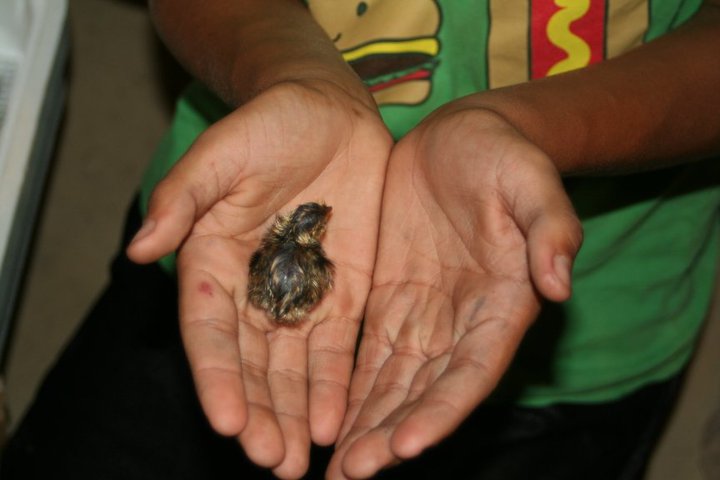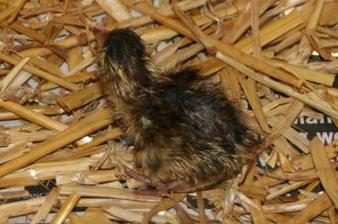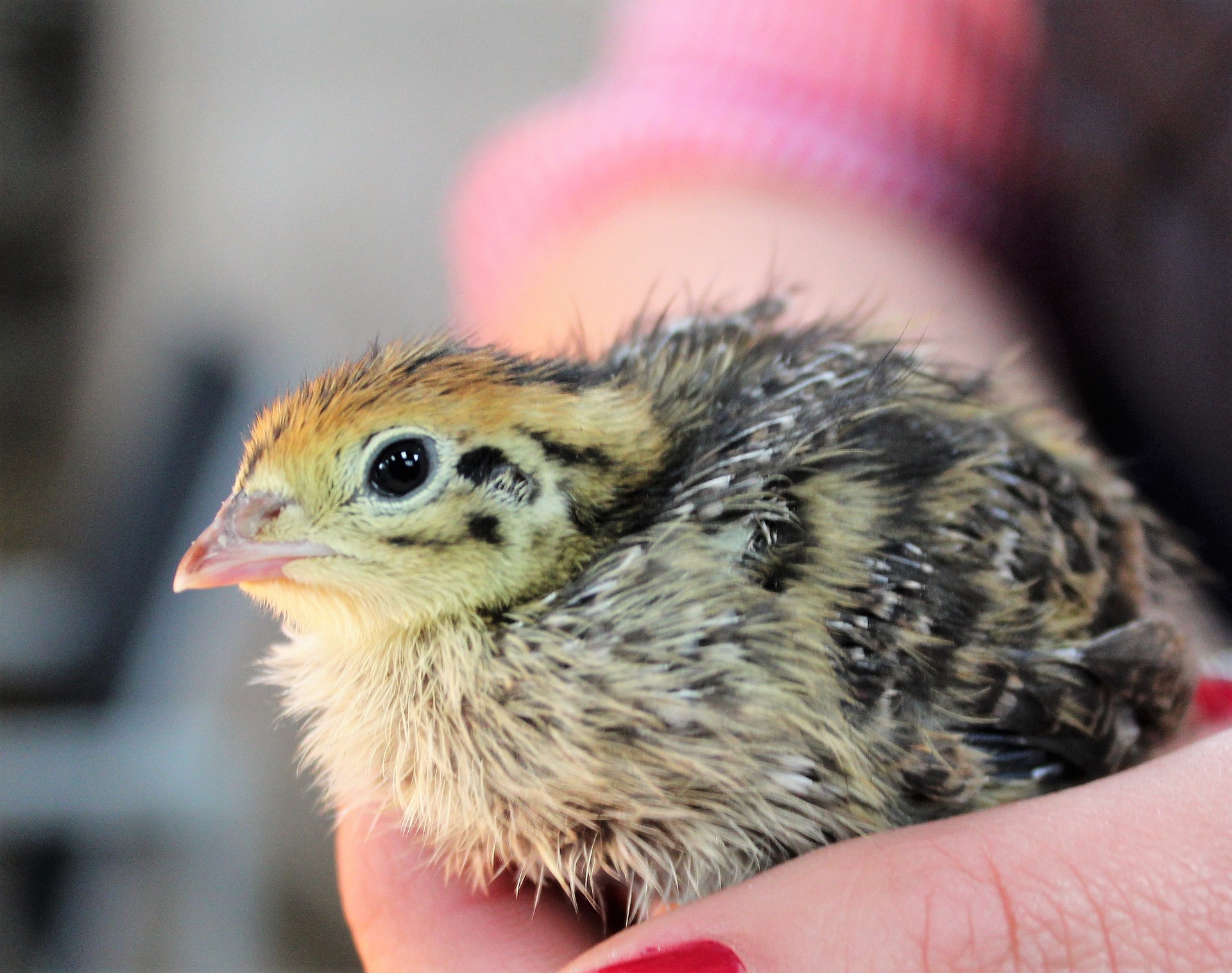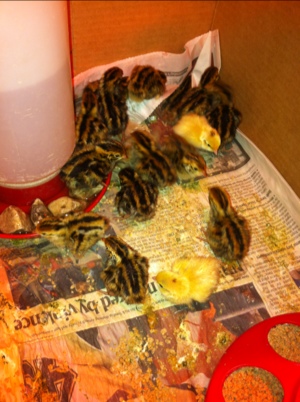How to easily raise day old quail chicks to maturity
The day has finally arrived! Your quail chicks are ready to hatch!
First of all, for the first 72 hours they are still absorbing the yolk sacks, so they can stay in the incubator. Therefore you can wait for a large group to hatch and limit the number of times you open the brooder and lose the built up heat.
Meanwhile, you need to focus on creating a brooder environment to house them in after you remove them from the incubator.
Day 0 – Brooder Setup
The brooder needs to have enough room for all the chicks you have room, plus food, water, and a heat source. I have used both square and round brooders. The general idea being a round brooder doesn’t have any corners for chicks to get trapped in and crushed or freeze. I am currently using a 40 gallon square fish tank for the first few weeks, then switch to a 275 gallon food grade tote cut in half.
Regarding the heat source. There are a couple of a couple of schools of thought. The usual source is a brooder lamp, typical to what they sell for chickens. A large bulb with a metal shield to direct most of the heat down. I used this type when I first got started and it worked fine.
Then after some reading, I switched to a red bulb, which is supposed to help cut down on the chicks pecking each other. Since that was really never a problem for me, I can neither confirm nor deny.
The important part is to maintain the correct amount of heat and allowing for room in the brooder for the chicks to move out and away from the heat source if they get too hot. The one real problem I had with this setup was if the bulb went out the chicks died.
I now use a chick brooder heating plate. This allows the quail chicks to move into and out of the even heat easily. While I could lose electricity or have this unit break, that is less likely than a bulb burning out. It also allows the chicks to be accustomed to day/night light cycles instead of light 24/7.
 Baby Quail
Baby QuailDay 1 – Get your quail chicks off to a great start with Miracle Water!
Add 2 cloves of garlic, 2 Tablespoons apple cider vinegar and ½ cup of honey per 1/2 gallon to the quail chicks water.
I completely stole this idea from Justin Rhodes at Abundant Permaculture, but using his recipe for water during the first week has changed how I raise chicks. I haven’t lost one quail chick since using it. They get a great start and finish strong.
I also don’t recommend using municipal tap water, as it contains too much chlorine and fluoride. If you have access to a well or can use filtered water it is much better for the quail.
Finally, young quail are susceptible to drowning or getting wet and sick from waterers. Make sure your chicks have access to the water, but can’t get fully into it or their head into the waterer. I use a quart jar chicken waterer and fill the rim with rocks to keep the chicks from getting full access. Check the picture at the top.
Week 1 – Temperature is the most important thing to monitor
Beyond food and water, the real issue for the first week is the temperature in the brooder. The transition from the incubator to the brooder is critical.
Start the heat off at 95 to 97 degrees Fahrenheit. Use a good working thermometer, a few degree can kill your quail. Then lower the temperature by 5 degrees each week until they are fully feathered out.
The chicks will need around 1/2 square foot each in the brooder. Then provide around 1 square foot per chick after 3 weeks of age.
 Baby Quail on straw
Baby Quail on strawWeek 2 – Quick growth comes from great nutrition
Overall quail need a high quality, high protein feed. Especially chicks to get a good start. I use a non-medicated game bird starter feed with 30% protein for the first six weeks.
**IMPORTANT** Initially baby quail need finely ground feed. If your starter feed is too coarse, it will need to be ground up before it is fed to baby quail. This will make it more palatable to the chicks.
Start with a small amount on paper towels to make sure that all birds begin eating. Then make sure they have feed available at all times.
Weeks 3-5 – Teenagers always active and in trouble
Between you and me, this is the worst part. The chicks get very active as they are starting to feather out and the mayhem begins. Spilling the water, pooping in the feed, and sometimes escaping from the brooder.
You will need to check on them often during this time to make sure they have feed, clean water, and a good heat source. Again, you should be reducing the temperature 5 degrees each week.
The other problem is space. As the quail chicks grow and feather out fully, make sure the brooder is large enough to handle them. They require at least 1 square foot per bird at this stage.
 Quail Chick
Quail ChickWeeks 6-8 – Mature birds need to be separated by gender and size
Now the fun begins. During these last two weeks, the birds are maturing, as in sexually maturing. You will need to begin to separate the boys from the girls and for the most part boys from too many boys to keep down the pecking and bullying.
At this stage, I look to either create (replace) breeding trios in my flock. I keep 1 male to 2 female. Others keep more females, but for the cortunix quail in my setup I have found this ratio works the best. Since I breed for size, I have also selected for fast growth and overall size.
Finally, culling. At eight weeks of age the birds are fully mature and ready to be harvested. Check out my post on the processing restraining cone build. Quick and easy way to do the deed.
It is pretty simple steps that will help you to easily raise day old quail chicks to maturity. Stay on top of the heat, feed, and water and everything should be fine.
Got questions, check this FAQ post.

In week one, your water mixture does not indicate the volume of water. Is this per gallon?
The ratios are per 1/2 gallon of water.
Per 1/2 gallon of water – will update the post.
To get a covey started and keep it going, you have the option of purchasing fertilized eggs to hatch in an incubator, allowing your quail hens to set their own eggs or purchasing day-old quail chicks (aka cheepers).
Have you ever considered using alternative methods such as natural incubation or brooding in order to raise your quail chicks to maturity, and if so, what challenges did you face and how did you overcome them?
The jumbo brown cortunix quail that I raise and recommend for meat/egg production have been breed over time to remove broodiness and would make horrible mothers. This may not be true for other breed of quail.